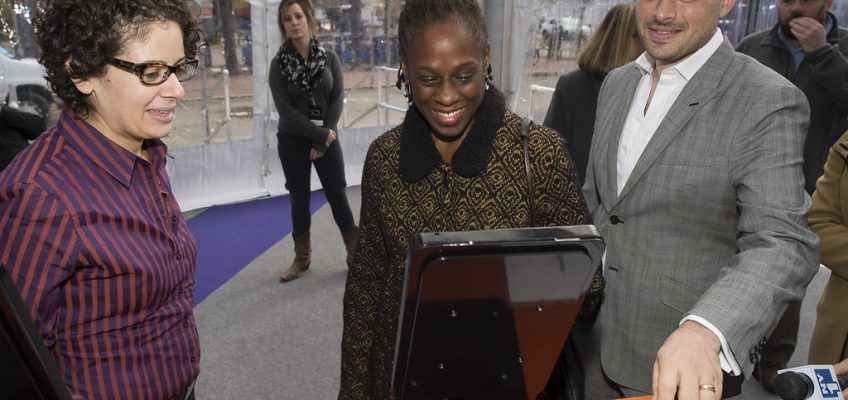“Rather than rely solely on the new mayor or pundits to interpret the results, the transition tents served as an informal poll of what New Yorkers really wanted.”
Former First Lady Chirlane McCray visiting the “Talking Transition Tent” in lower Manhattan in November 2013. (Credit: Rob Bennett for the office of Mayor-elect Bill de Blasio)
More than a decade ago, New York City prepared for a new mayor who’d energized the electorate with big promises. Earlier this month, Zohran Mamdani woke up after election night with the same big challenge Bill de Blasio faced in 2013: how to translate the elegant campaign poetry into practical governing prose.
Our new mayor-elect would be wise to look to New Yorkers for help. Borrowing an idea from 2013 would go a long way to making this happen.
To be sure, newly-elected mayors have precious little time to get ready for Day 1, what’s called the mayoral transition period. For the next month and a half, Mamdani has a lot to do, especially for the staffing of his administration. He’ll need to make appointments at three dozen city agencies and more than 200 commissions and boards.
The work to figure out who to keep and who to replace, as well as how to implement his policy agenda, may have begun during the campaign—but the hard work starts now during the transition.
In 2013, civic leaders recognized this challenge as well as the risks of making all these hard decisions without public input. On Nov. 9, they erected the so-called Talking Transition Tent on Canal Street, and, for three weeks, invited all New Yorkers to visit and share their best ideas on 50 iPad terminals.
Nearly 70,000 people showed up for that experiment in shared governance, including two leaders of de Blasio’s transition team who toured the tent and indicated that they welcomed the input.
One thing the transition tent in 2013 did was to clarify public sentiment. Rather than rely solely on the new mayor or pundits to interpret the results, the transition tents served as an informal poll of what New Yorkers really wanted.
The result was hardly surprising then, and in retrospect, reveals much about why the city just elected a newcomer with bold ideas this time around. Over two-thirds of participants told the transition tent organizers that housing affordability was their number one concern, the most of any issue. In so many ways, the problems of the city remain the same; figuring out new ways to address them is Mamdani’s chief challenge.
There’s another reason why the Talking Transition Tent provided important new information for the incoming administration. Many of the New Yorkers who showed up at the tent (just under 40 percent) hadn’t voted in the 2013 election. Whether they were too young to vote or simply not eligible for some other reason, these New Yorkers were given the opportunity to participate in the planning of the new administration and they took it.
Newly-elected Mayor Mamdani should invite civic leaders to bring back the transition tent, but to do it even better. Back then, 10 foundations underwrote the cost of the transition tent—the total bill was estimated to be just a couple of million dollars. Surely they can find that money again.
This time, they should go even bigger. Rather than one tent located in Lower Manhattan, dozens of tents should be set up in all five boroughs. The goal should be to get a half a million New Yorkers of all ages, partisan affiliations, and political ideologies to help the new mayor get ready to govern.
Mr. Mamdani made a point of visiting every corner of the city during the campaign, seeking out support among voters who’d never before been invited to participate. His mayoral transition offers another opportunity to fulfill his promise to govern for all New Yorkers. Seeking out their advice in tents set up around the city during the transition is the right way to do that.
Heath Brown is a professor of public policy at John Jay College, City University of New York.
The post Opinion: Bring Back the Mayoral Transition Tent appeared first on City Limits.


Leave a Reply